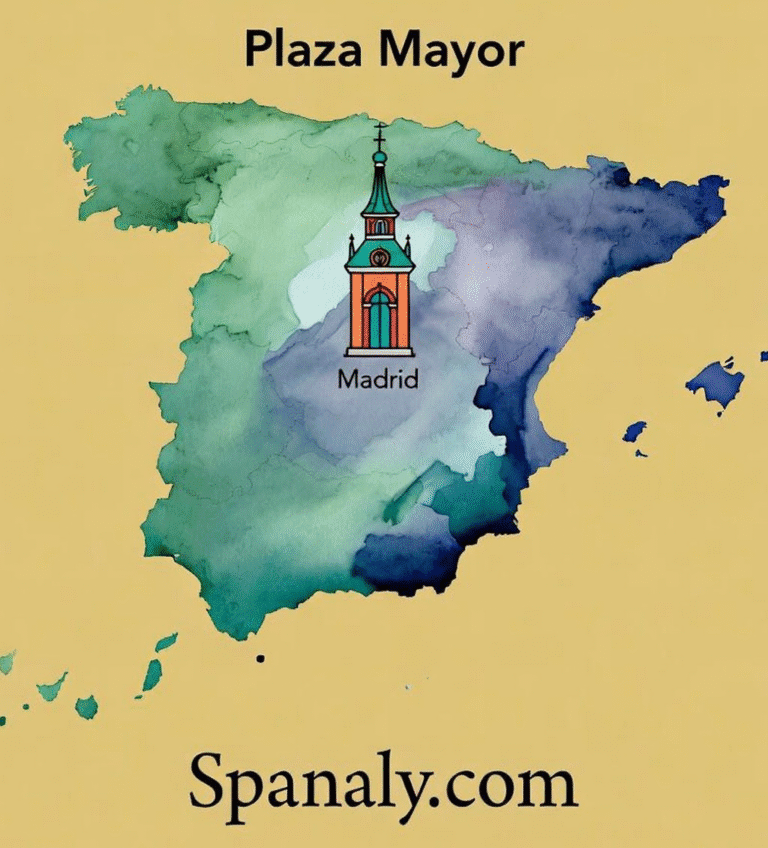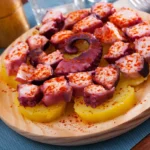Table of Contents
ToggleA Journey Into Madrid’s Soul
At the very center of Madrid lies Plaza Mayor, a place where
centuries of history, art, and daily life blend into one living
masterpiece. Every arch, every balcony, and every echoing footstep tells
a story that began more than 400 years ago. (For complete and detailed
itineraries that cover all of Madrid’s historic core, refer to our
comprehensive master guide.) Unlike many famous landmarks that tourists
pass through quickly, Plaza Mayor rewards those who linger — those who
stop to feel the rhythm of Madrid’s beating heart. Step into the square
at sunrise, when golden light touches the red façades, and you’ll sense
the soul of a city that has never stopped celebrating life. Plaza Mayor
is not just a monument; it’s a living theater, where past and present
meet, and where Madrid reveals its true character — warm, passionate,
and endlessly alive.
From Market to Majesty: The Birth of Plaza Mayor
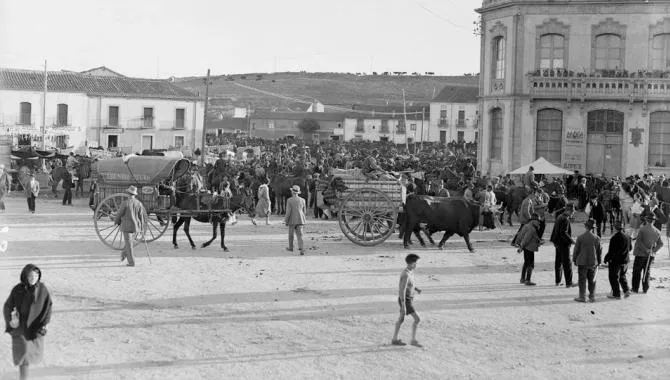
Before the elegant arcades and royal balconies, this area was known as Plaza del Arrabal, a busy marketplace outside the old city walls. Merchants gathered to sell fabrics, leather, and spices brought from across Spain.
In 1590, King Philip II decided Madrid needed a public square worthy of a European capital. His successor, Philip III, commissioned the great architect Juan Gómez de Mora, who transformed the market into a grand stage of Baroque architecture. The square was completed in 1619, and the magnificent statue of Philip III, crafted by Giambologna and Pietro Tacca, still stands proudly at its center today.
Through the centuries, Plaza Mayor became the scene of royal processions, bullfights, markets, festivals, and even public trials during the Inquisition. Each era left its mark — visible today in the stones, carvings, and hidden corners of the square
Architecture and Artistic Harmony
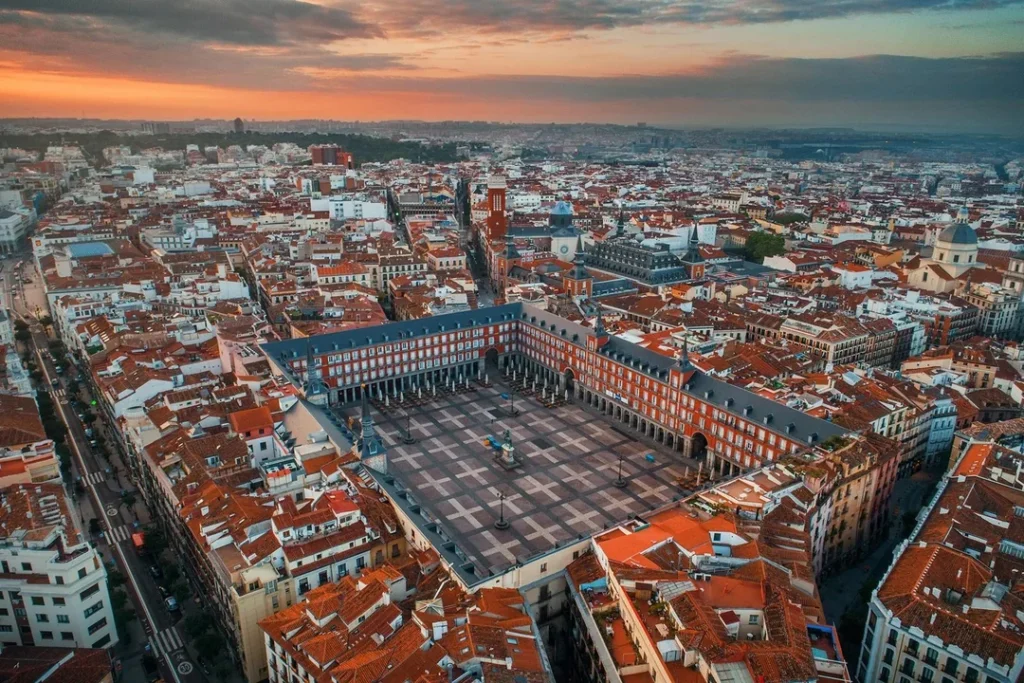
At first glance, Plaza Mayor seems simple: a vast rectangle surrounded by symmetrical red-brick buildings. But a closer look reveals subtle artistry. The square measures 129 meters long and 94 meters wide, enclosed by three-story buildings with 237 balconies, all facing inward — a perfect frame for life unfolding below.
The most famous building is the Casa de la Panadería, originally the city’s main bakery. Its façade, painted with allegorical frescoes by Carlos Franco, tells stories of Madrid’s myths and spirit. Opposite stands the Casa de la Carnicería, once the meat market, now serving as an elegant building for events and municipal offices.
Enter through one of the nine arches — especially the Arco de Cuchilleros — and you step into another era. Beneath the arcades, cafés and taverns have stood for centuries, their walls echoing with the laughter of travelers, artists, and locals alike
Experiencing Plaza Mayor: A Day in the Square
Morning: Quiet Majesty and Hidden Corners
Start early, when the square is calm and bathed in soft morning light. Locals hurry through with coffee cups, and street cleaners finish their work. Sit at one of the cafés under the arches — Café Los Galayos or Bar La Torre del Oro — and watch the city wake up.
As you sip your espresso, imagine the centuries of life that passed before you. Plaza Mayor was rebuilt three times after devastating fires (in 1631, 1670, and 1790). Architect Juan de Villanueva, after the last fire, gave it the neoclassical appearance we see today — elegant, balanced, and distinctly Madrileño.
After breakfast, wander around the square’s edges. Look closely at the façades — you’ll notice tiny symbols carved into stone, representing the city’s ancient guilds of merchants and craftsmen. These are hidden treasures most tourists never notice.
Afternoon: Food, Flavors, and Street Life
By midday, Plaza Mayor bursts into life. Musicians tune their guitars, artists sketch portraits, and the smell of traditional Spanish food fills the air.
No visit is complete without tasting Madrid’s signature snack — the bocadillo de calamares (fried squid sandwich). Several bars just outside the square serve the best ones, especially along Calle de los Cuchilleros. Pair it with a cold beer or tinto de verano for the perfect local lunch.
For dessert, take a short walk to Chocolatería San Ginés, one of Madrid’s oldest cafés, for classic churros con chocolate — a sweet treat featured in our guide Spanish Cuisine in Depth
Around the arcades, browse small shops selling hand-painted ceramics, traditional fans, and leather goods. While souvenirs are common, look for items Made in Spain — many artisans still use age-old techniques passed down through generations
Evening: Lights, Music, and Madrid Magic
As the sun sets, Plaza Mayor transforms. The façades glow in golden light, and music fills the air. Locals gather to meet friends, and street performers bring laughter to the crowd.
During summer, open-air concerts and flamenco shows often take place, creating an atmosphere that captures the spirit of Spain — expressive, emotional, and alive. Sit at a terrace with a glass of Rioja wine, and watch as the square becomes a living painting
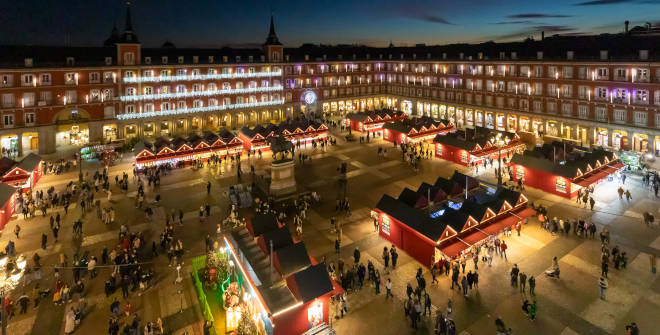
Seasonal Magic and Cultural Events
Each season brings a new face to Plaza Mayor:
Spring: The air is fresh, and café terraces bloom with flowers. Often, photography exhibitions or local art fairs take place.
Summer: Live music, traditional dances, and evening shows fill the square with rhythm and color.
Autumn: A peaceful season when locals reclaim the square, perfect for exploring nearby gems like the Royal Palace of Madrid
Winter: The most magical time. The Christmas Market of Plaza Mayor dates back to the 19th century and fills the square with wooden stalls, handmade ornaments, and warm lights.
If you visit in December, don’t miss trying turrón, mazapán, or warm mulled wine sold at festive stalls. The atmosphere is pure enchantment — a tradition loved by both locals and visitors
Nearby Treasures: What to See Around Plaza Mayor
Plaza Mayor sits in the heart of old Madrid, surrounded by must-see attractions:
Puerta del Sol: The symbolic “kilometer zero” of Spain, just a 5-minute walk away.
Mercado de San Miguel: A gourmet food market offering tapas, wine, and local delicacies — a must-visit for food lovers.
The Royal Palace: A stunning landmark filled with history, art, and royal elegance.
Teatro Real: Madrid’s grand opera house, just beyond the square.
El Rastro Market: On Sundays, walk south to explore one of Europe’s oldest flea markets.
For those exploring Spanish traditions, continue your journey through our guide Semana Santa in Spain: Passion and Tradition to discover how faith and celebration shape the nation’s identity
Insider Tips for Travelers
Best Time to Visit: Early morning for peace, sunset for atmosphere.
Avoid: Dining in the central terraces can be pricey — explore nearby side streets for authentic local food.
Dress Comfortably: Cobblestones can be uneven; wear good shoes.
Stay Nearby: Hotels around Plaza Mayor give you front-row access to Madrid’s nightlife and morning charm.
Photography Tip: The best light hits the north side of the square around 8 AM and again at sunset.
Beyond the Square: A Deeper Connection
Plaza Mayor is not just a destination — it’s a living memory of Madrid’s soul. From the quiet mornings when the city stretches awake, to the electric nights filled with laughter and song, it reflects everything that makes Spain unique: warmth, tradition, resilience, and joy.
For travelers who wish to go beyond the surface, Plaza Mayor offers something rare — authentic connection. Talk to a local vendor, taste something homemade, listen to a busker’s song. These moments, not souvenirs, are what truly stay with you
Rich Conclusion: Madrid’s Eternal Square
In a world where cities constantly change, Plaza Mayor remains timeless. It has survived fires, revolutions, and centuries of transformation, yet its essence never faded. Here, Madrid’s history breathes through the arches, its art lives on the walls, and its spirit dances in every step.
To visit Plaza Mayor is to understand Madrid — not through museums or monuments, but through the rhythm of its everyday life. Whether you come for history, food, or simple curiosity, the square rewards you with something deeper: a sense of belonging to a story that has no end.
Plaza Mayor is not just the heart of Madrid — it is the heartbeat of Spain itself
External Link :
❓ FAQ about Plaza Mayor, Madrid
What is Plaza Mayor in Madrid known for?
Plaza Mayor is famous for its grand architecture, vibrant events, and historical role as Madrid’s main public square since the 17th century.
Can you visit Plaza Mayor for free?
Yes! Plaza Mayor is open to the public 24 hours a day, and there’s no entry fee.
Do people live in Plaza Mayor, Madrid?
Yes, the upper floors of the surrounding buildings still contain private apartments with beautiful views of the square.
What events happen at Plaza Mayor?
The square hosts Christmas markets, cultural festivals, and live performances throughout the year.
